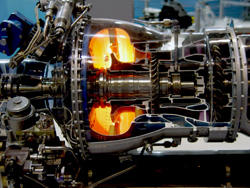Minimising combustion hazards
In the design of combustion engines, perhaps the most difficult challenge is the simultaneous optimisation of efficiency, stability and pollutant emissions. Premixing fuel and air in lean proportions prior to combustion has enabled large reductions in pollutant emissions, especially nitrogen oxides (NOxs). Unfortunately, this well established system in combustion engine manufacturing technology is prone to flame instabilities. Modelling and numerically simulating the intricate coupling of chemically interacting flows during combustion has therefore become profoundly important to the design of gas turbine engines. The MUSCLES project partners succeeded in modelling the interaction between turbulent mixture and chemical reaction by calculating the statistical probability for all occurring states during turbulent combustion processes. The approach adopted by researchers at the Universität Karlsruhe in Germany involved the computation of the probability density function (PDF) of the most important parameters. These included turbulence length scales, velocity and mass fractions of individual species in the burned fuel mixture, in addition to appropriate time scales for chemical reactions. The probability density functions of each parameter would have to directly solve transport equations of their joint probability density function (JPDF). The JPDF combustion model was extended to describe highly diluted combustion under turbulent conditions and was applied to simulate flame extinction in the lean limit, known as lean blow-out. Further reduction of pollutant emissions will require even leaner mixtures of fuel and air, as well as new schemes exploiting this combustion technique to its maximum potential. By extending the lean blow-out limit, lower temperatures could be reached and consequently, less NOx emissions produced. Initial calculations were successful in predicting the lean blow-out limit of the combustion system and have opened the way to reducing the test costs of combustor development programmes.







